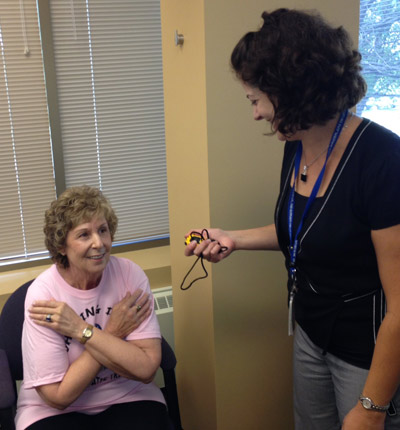 |
Pat Ryan (left), a patient with primary orthostatic tremor (OT), goes through a sitting-standing maneuver under the direction of Lori Schmaderer, a physical therapist with The Nebraska Medical Center. Ryan, who is from Hixson, Tenn., is one of more than 50 OT patients who came to Omaha to participate in the largest study ever done with OT patients. |
It’s called primary orthostatic tremor (OT), and this week UNMC is hosting more than 50 OT patients from around the world in what is the largest study ever done with OT patients.
“It’s a very rare condition, so it’s quite an achievement to get so many patients to congregate in Omaha,” said Diego Torres-Russotto, M.D., a movement disorders specialist at UNMC. “OT is a miserable disease. Hopefully, this study will help us come up with some answers for these people.”
Dr. Torres-Russotto, who is an associate professor in neurological sciences, said patients will be coming from Spain, England, Canada, Australia and the United States.
Facts about OT
Some facts about OT include:
- It is more common in females.
- There’s usually a 10-15 year lag between onset of symptoms and diagnosis.
- Onset typically occurs around age 40.
- It won’t kill you, but it typically gets worse over time.
- Diagnosis is confirmed through electromyography, or EMG, a test that measures the electrical activity of muscles.
- By touching something, the feeling of falling improves.
For more information on OT, click here.
The International Orthostatic Tremor Meeting started Monday evening and will run through Friday. This marks the second time Omaha has hosted the event, with the previous Omaha meeting held in 2012. Last year, the meeting was held in Australia.
The patients will each undergo a two-hour physical examination by a movement disorder specialist and a physical therapist, as well as electrophysiological studies. The goal of the study will be to determine if the patients really do have postural instability and to assess the presence of ataxia, a neurological sign consisting of lack of voluntary coordination of muscle movements.
Dr. Torres-Russotto said participants in this year’s study will go through four new features:
- They will undergo an electroencephalogram (EEG) test, which records brain waves in an effort to determine the place in the brain that is causing the problems. Najib Murr, M.D., assistant professor, neurological sciences, will be performing and analyzing the EEG arm of the study.
- They will test a smart phone app that can be used to diagnose the disease by measuring tremors in the legs.
- They will receive specialized video analysis developed at Massachusetts Institute of Technology.
- They will receive psychiatric assessment by a UNMC psychiatrist, Mark Fleisher, M.D., that will attempt to measure their level of suffering.
OT is characterized by high frequency tremors of the legs when in a standing position and an immediate sense of instability. Because of the speed of the contractions, OT is often not recognized as a tremor when compared to essential tremor or Parkinson’s disease.
Dr. Torres-Russotto said OT is greatly underdiagnosed and often misdiagnosed as other neurological problems such as Parkinson’s, essential tremor or psychogenic problems.

This a concise description of the research study that I attended in Omaha last month. Thought you all might be interested.